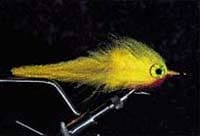
Cape Cod surf guide Tony Stetzko catches so many large bass that he is known throughout the East Coast as “striperman.” Stetzko moved to the Cape specifically to take better advantage of what he feels is the best coastal fishery in America. He has taken stripers to 73 pounds, including many over 40 pounds, on the fly. Nothing gets Striperman going like putting people onto really big fish, and the best time to do that, he says, is during the spring and fall runs.
Whether they are headed to Boston Harbor, Stellwagen Bank, the coast of New Hampshire or the Gulf of Maine, nearly every migratory striper has to pass by Cape Cod’s Outer Beaches. A lot of these stripers will travel inshore to feast on the large herring that drop out of the ponds and rivers as the water warms. To imitate these big baits, Stetzko carries just one pattern, a large Lefty’s Deceiver dressed in yellow or black, winged with fly fur rather than bucktail.
“Lefty’s Deceiver is my favorite pattern for imitating any large baitfish,” Stetzko says. “It is durable, castable, easy to tie and presents the right profile in the water. During the spring run I carry only two colors: all yellow for daytime and moonlit nights, and all black for dark nights. The Fly Fur wing presents a nice, deep profile and pulsates in the water, providing great action on the retrieve. It also sheds water better than bucktail, making these big flies easier to cast.”
Stetzko’s standard Deceiver is tied about 7 inches long on a 3/0 hook. Both the yellow and black dressings receive a throat of red fur to suggest gills, and a large 3-D eye.
Stetzko first learned about this Deceiver variation from talented Welfleet tier Joel Fox. When he can find the right hackle, Fox ties them even larger on hooks up to size 5/0.
Stetzko doesn’t really begin fishing hard until the larger fish arrive, usually around the beginning of May.
“A lot of people don’t think that big stripers can be caught that early, but I find that they are always here much earlier than conventional wisdom dictates,” he says. Stetzko adds that large bluefish are an added bonus during those first few weeks, but they are usually gone before most fishermen have even dusted off their gear.
“A second wave of big stripers usually arrives around the beginning of June, providing great action all over again,” Stetzko says. “By the time the beach begins to get crowded with fishermen, the best early-season fishing is already over.”









